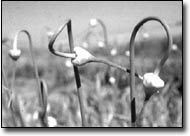|
by Chef Boy Ari
 G
rowth comes suddenly in the garlic patch this time of
year; maybe you don't even notice until they are 6 inches
long. A green shoot emerges from the top of each plant,
and over the next few weeks it coils itself around in
circles, like a snake ready to strike. G
rowth comes suddenly in the garlic patch this time of
year; maybe you don't even notice until they are 6 inches
long. A green shoot emerges from the top of each plant,
and over the next few weeks it coils itself around in
circles, like a snake ready to strike.
The technical name for this beautiful and delectable
apparatus is "scape." Such a harsh name - sounds more
like an injury or a disease or misplaced blame - is a
cruel injustice to the world of pleasure the name represents.
That's why I refer to them as flowers, despite the fact
that botanists advise otherwise. At least I'm not alone.
Whatever you call these garlic thingies, they have a mild, sweet flavor, a
mesmerizing neon-green color that's enhanced by light cooking, and a whimsical
shape that's conducive to sauce-dipping. It's also the stuff of epic springtime
parties. Invite your friends to eat garlic flowers, breaded and deep-fried,
or roasted in olive oil. Or wrap the scapes around your wrists and traipse
about like Greek gods and goddesses. A0
Or better yet, Asian gods and goddesses, for it was
the Asians who first latched onto the pleasures of garlic
flowers. The Buddha himself would have been a great fan
if they didn't make him so dang horny. Me, I ate my first
garlic flower in China, riding north on the train toward
Mongolia. I made my way to the dining car, where there
was no menu, and where I was served stir-fried pork and
chopped garlic flowers in a mild oyster sauce.
While garlic flowers have long been a seasonal delicacy
across Asia, as well as in many parts of Europe, here
in the U.S. we are catching on slowly. And we may soon
lose our chance, as the American garlic market is now
flooded with cheap garlic from China. While California
supplies 85 percent of this nation's garlic, China supplies
66 percent of the world's garlic, a percentage that's
rapidly growing. Despite a recently imposed 367 percent
tariff on Chinese garlic imports, distributors and processors
in Gilroy, Calif. - the undisputed garlic capital of
America - are still buying garlic from China. Meanwhile,
North American garlic production is down.
The type of garlic that's usually grown for mass cultivation,
including the Chinese imports, is called soft-neck garlic.
One of the reasons soft-neck is grown on a large scale
is that it's less labor intensive and doesn't produce
those flower-like things of which I wax so fervently.
And with increasing market pressure, growers will be
more likely than ever to favor the soft-necks.
The flowering kind of garlic, called hard-neck, is more
labor intensive because the flowers must be picked. Otherwise,
energy and resources will go to the growing cluster of
miniature garlic cloves that form at the end of the flowering
stalk, while the growth of the below-ground bulb - which
is what goes to market - is stunted. This is the same
principle that's behind castrating meat animals, like
steers and hogs. Without the need to expend bodily resources
on reproduction, the animal grows larger.
Thus, whether your garlic comes from Gilroy or China,
if it's grown on a large scale it won't flower, and that's
why the flowers are a rare sight at the market. But an
increasing number of small-scale, gourmet growers are
turning to hard-neck garlic, for a number of reasons:
It tastes better, peels like a prom dress, produces beautifully
symmetrical bulbs, and sends up those delectable flowers.
If you are lucky enough to get your hands on some, there
is no better way to usher in the garlic season.
With these curly-stocking-capped morsels, you can do
anything you would do with regular garlic. Or, capitalize
on the shape for presentation points. Steam them like
asparagus and serve drizzled in lemon butter aside broiled
antelope back strap; add a few to the simmering Thai
coconut chicken soup two minutes before serving, and
watch them curl around the bowl; or, unwrap a flower
from your wrist, bite by bite, as you co-munch neon-green
garlic with whatever is on your plate.
If you want to find garlic flowers, visit your farmers
market in mid-to-late June. Or try the specialty produce
shops. If you still can't find any, hop online and go
to www.dakotagarlic.com/garlic_scapes.htm. Dakota Garlic
is a family farm in North Dakota specializing in many
varieties of hard-neck garlic, which means they have
plenty of flowers in June, and they will be happy to
ship you some. They also have a recipe page full of tips
for garlic flowers, which they call scapes.
And if you are lucky enough to have some garlic in the
ground, pick the flowers before they start to uncurl.
I like to pull straight up with a smooth gentle tug,
like pulling a blade of grass. Sometimes the flower stalk
breaks deep inside the plant, and what slides out is
the most tender bit of garlic flavor you can imagine.
In a brown paper bag in the fridge, they will keep for
weeks. But as with most things, fresh is best.
|